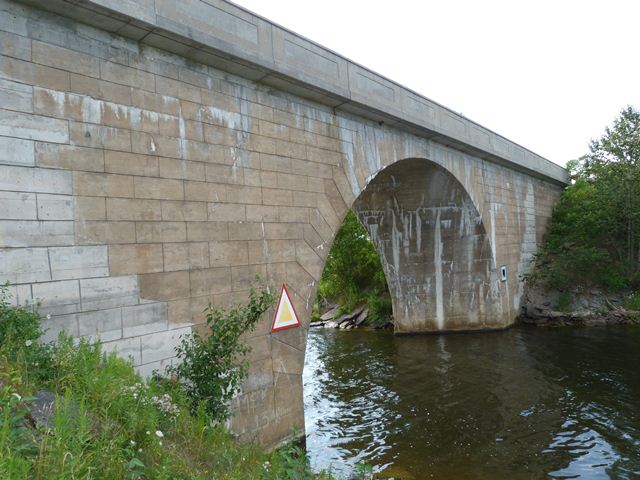We Recommend:
Bach Steel - Experts at historic truss bridge restoration.
BridgeHunter.com Phase 1 is released to the public! - Visit Now
Canal Lake Bridge
Hole in the Wall Bridge

Primary Photographer(s): Nathan Holth and Rick McOmber
Bridge Documented: July 21, 2012
Centennial Park Road (Highway 33) Over Canal Lake (Trent-Severn Waterway)
Rural: Kawartha Lakes City, Ontario: Canada
1905 By Builder/Contractor: Unknown and Engineer/Design: Department of Railways and Canals
1987
60.0 Feet (18.3 Meters)
Not Available
Not Available
1 Main Span(s)
Not Applicable

View Information About HSR Ratings
Bridge Documentation
View The Patent For Melan Arch Reinforcing
This bridge was designated in 1988 as a National Historic Site of Canada, the highest official honor for a bridge in Canada. Designation is well-justified. The bridge is the oldest concrete arch bridge known to remain in Canada with a 1905 construction date, a date which is cast into the center of the arch. Constructed in 1905, this was still an early and somewhat prototypical period in the use of concrete for bridge superstructures. Often in these early periods, patented or otherwise diverse methods of reinforcing the concrete were used as different engineers worked to find what method worked best to strengthen the concrete for bridge construction. In the case of the Canal Lake Bridge, the Melan system of reinforcing was used. This form is exceedingly rare among surviving bridges in North America. Rather than reinforcing rods such as those used in concrete today, the Melan reinforcing system uses solid steel beams inside the concrete, usually shaped in an arch shape to follow the contour of the concrete arch. In an extremely rough sense a Melan arch might be thought of as a steel arch bridge encased in concrete, however the steel in a Melan arch would be less elaborate and extensive. The Melan system of reinforcing was first invented and patented by Joseph Melan in 1893.
The bridge's concrete has lines cast into it to create the pattern of stones laid out in a stone arch bridge. This practice is not unusual in the earliest of concrete arch bridges. At this time, concrete arch bridges were something new, and stone arch bridges were much more familiar. Also, engineers may have not felt comfortable enough with the new material to take full advantage of the unique opportunities concrete provides for architectural enhancement. Instead, placing the lines in the concrete was an easy way to create an aesthetic based in the familiar form of a stone arch bridge.
The Canal Lake Bridge was rehabilitated in 1987. The current deck configuration, which appears to date to this rehabilitation, appears to have been widened slightly beyond the original design by cantilevering the deck out beyond the arch slightly. As such, the original railings do not remain on the bridge. The existing railings are solid concrete parapets that have inset rectangular panels on the outside, and these may replicate the original appearance.
Information and Findings From Canada's Historic PlacesDescription of Historic Place The Canal Lake Concrete Arch Bridge National Historic Site of Canada which spans the Trent-Severn Waterway near the settlement of Bolsover, Ontario, is a sturdy concrete bridge comprised of a single arch braced by abutments on either shore. The appearance of the arch, which forms an almost complete semi-circle over the waterway, was enhanced by markings on the concrete surface, which simulate the voussoir stones of masonry arches and the coursed stonework of stone masonry bridge abutments. It is one of several remarkable engineering works associated with this navigational waterway. The designation refers to the bridge on its footprint at the time of designation (1988). Heritage Value Canal Lake Concrete Arch Bridge was designated a national historic site of Canada in 1988 because: - it is the earliest known reinforced concrete bridge in Canada. The heritage value of this site resides in its design and early use of reinforced concrete as illustrated by the surviving original structure. Designed as a plain concrete structure, several significant modifications made to the bridge's plan shortly before construction drove the canal engineers to add reinforcing to the concrete structure. However, the engineers failed to take full advantage of the design properties of a reinforced concrete arch and as a result, the arch ring and abutments remained much heavier than necessary. Although the bridge was the first to use reinforced concrete in Canada, in its configuration and mass, its design closely resembles earlier arch bridges in plain concrete, and consequently, approximate the appearance of the traditional stone masonry arch bridge. After its use on the Canal Lake Concrete Arch Bridge, reinforced concrete became the primary building material of other major canal structures along the Trent-Severn Waterway National Historic Site of Canada, including the Rosedale Lock (1908) and the Bobcaygeon Dam (1909). Thereafter, reinforced concrete totally superseded the earlier employment of plain concrete. Source: Historic Sites and Monuments Board of Canada, Minutes, June 1988. Character-Defining Elements Aspects of the site which contribute to its heritage value include: Heritage Designation and Type: National Historic Site of Canada |
This bridge is tagged with the following special condition(s): Melan
![]()
Photo Galleries and Videos: Canal Lake Bridge
Bridge Photo-Documentation
Original / Full Size PhotosA collection of overview and detail photos. This gallery offers photos in the highest available resolution and file size in a touch-friendly popup viewer.
Alternatively, Browse Without Using Viewer
![]()
Bridge Photo-Documentation
Mobile Optimized PhotosA collection of overview and detail photos. This gallery features data-friendly, fast-loading photos in a touch-friendly popup viewer.
Alternatively, Browse Without Using Viewer
![]()
Maps and Links: Canal Lake Bridge
Coordinates (Latitude, Longitude):
Search For Additional Bridge Listings:
Additional Maps:
Google Streetview (If Available)
GeoHack (Additional Links and Coordinates)
Apple Maps (Via DuckDuckGo Search)
Apple Maps (Apple devices only)
Android: Open Location In Your Map or GPS App
Flickr Gallery (Find Nearby Photos)
Wikimedia Commons (Find Nearby Photos)
Directions Via Sygic For Android
Directions Via Sygic For iOS and Android Dolphin Browser

